Rule Exception Requests
Updated March 2024 – Academic Affairs
Table of Contents
- Step 1: Generate the Rule Exception Request
- Step 2: Approver Receives Request
- Step 3: Approver Submits Decision
- Step 4: Schedule Builder Tracks Request Details
- Unable to Submit Rule Exception Request?
The intent of a Rule Exception Request is for exceptions to established rules, or to create workflows for information to be updated.
Examples of Rule Exceptions: on-campus courses exceeding 39 students, and instructor not approved to teach a course (i.e. missing faculty qualifications).
There are three area within Coursedog to submit a Rule Exception Request:
- When editing a section
- Within the Requests tab
- When checking for conflicts, prior to submitting a department schedule for Validation
Step 1: Generate the Rule Exception Request
Option 1: When Editing a Section
- Identify the section within the Section Dashboard
- If there is a rule being violated that is set up for a Rule Exception Request workflow, the top of the section template will generate the option to ‘Submit Rule Exception Request’

- You will then be prompted to input a reason for the request
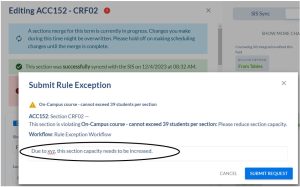
- Click ‘Submit Request’
- The section will then update showing that the Request has been submitted
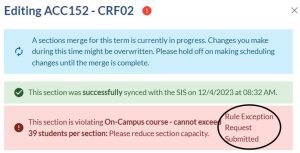
Option 2: Requests Tab ⇒ ‘Create Request’
This route would typically be used once you have created a new section in the Section Dashboard. Once created you would submit the Request through the Requests tab.
- Confirm that the term you are wanting to make a Request for, is the selected term in the Section Dashboard
- Navigate to Requests by clicking the hamburger menu (1) ⇒ Requests (2)
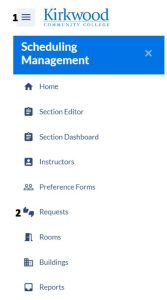
- Select ‘Create Request’
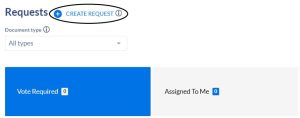
- Select the Request Type ‘Rule Exception’ from the dropdown (1) and click ‘Create Request’ (2)

- Input the Request details and Submit Request
- (1) The term will default to what is selected in the Section Dashboard. If this is not the term you need to submit a Request for, route back to the Section Dashboard and select the correct term, and then return to the Requests tab.
- (2) Select the course
- (3) Select the specific section you need to submit a Rule Exception Request for
- (4) Select the rule that you are submitting the Rule Exception Request for
- (5) Input the reasoning for the Request
- (6) Submit Request
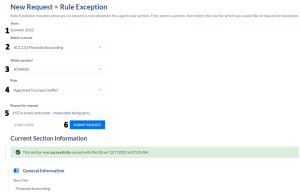
Option 3: When Checking Conflicts, Prior to Submitting a Department Schedule for Validation
- Navigate to Reports by clicking the hamburger menu (1) ⇒ Reports (2)
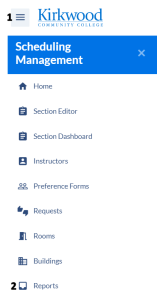
- Select ‘Conflicts’
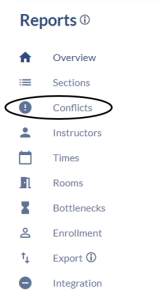
- Select the term and department you are preparing to submit for Validation

- Clean up conflicts that you are able to
- You are able to sort by conflict type, to learn more please reference Conflicts List – Report documentation
- As you navigate the list, you can simply click the section and it will take you into the Section Template to make the fix, or submit the Rule Exception Request. At this point, please submit any Requests for conflicts that have a workflow set up.
- Rule Exception Requests
- When you click into the section, those with a workflow set up, will prompt you to ‘Submit Rule Exception Request’


- When you click into the section, those with a workflow set up, will prompt you to ‘Submit Rule Exception Request’
- Rule Exception Requests
Step 2: Approver Receives Request
- The approver in the workflow will receive the Request notification
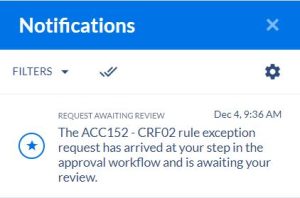
- To review the Request, the approver can click into the notification, or navigate to the ‘Requests’ tab
- For the specific Request, a few items the approver will see in the Request screen are:
- (1) When the Request was submitted, and by who
- (2) The reason for the request, as well as section details, and the rule violation that the Request was submitted for
- (3) Decisions eligible to select for the specific Request
- (4) Area to input a comment based on the decision

Step 3: Approver Submits Decision
- The approver will see eligible decisions for the specific Request – the most common are Approve, Reject, and Suspend. Below outlines each of those three options for the approver.
- Approve
The approver selects ‘Approve’ (1), then inputs a comment based on the submission (2), and clicks ‘Submit Decision’ (3)
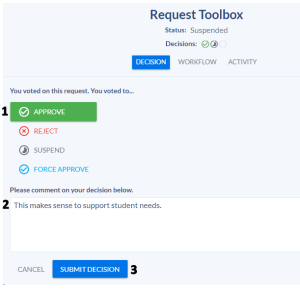
- Once the approver selects ‘Approve’ the specific Request will update. Immediately, the approver will see the following:

- Once the approver selects ‘Approve’ the specific Request will update. Immediately, the approver will see the following:
- Reject
The approver selects ‘Reject’ (1), then inputs a comment based on the submission (2), and clicks ‘Submit Decision’ (3)

- Once the approver selects ‘Reject’ the specific Request will update. Immediately, the approver will see the following:
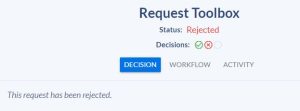
- Once the approver selects ‘Reject’ the specific Request will update. Immediately, the approver will see the following:
- Suspend
The approver selects ‘Suspend’ (1), then inputs a comment based on the submission (2), and clicks ‘Submit Decision’ (3)
Suspending a Request essentially pauses the Request. This is helpful to not miss the deadline set on the Request, but important to review the Request within reasonable amount of time.
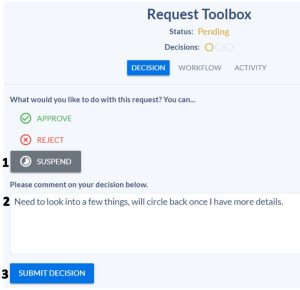
- Once the approver selects ‘Suspend’ the specific Request will update. Immediately, the approver will see the following:
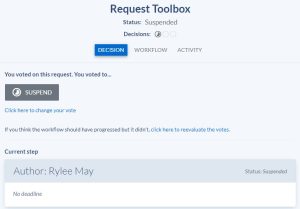
- When the approver is ready to update their decision, they will navigate to the Requests dashboard ⇒ ‘Vote Required’ (1) ⇒ select the specific Request (2) ⇒ select ‘Click here to change your vote’ (3)
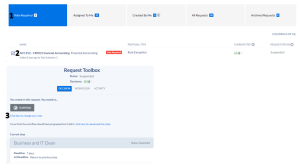
- From here, the approver can either Approve or Reject the Request
- Once the approver selects ‘Suspend’ the specific Request will update. Immediately, the approver will see the following:
- Approve
- Once the decision has been submitted as Approved or Rejected, the Request will clear from the ‘Vote Required’ tab within the Requests dashboard, and move to the ‘Assigned to Me’ tab (1) for the approver. Within this area, the approver can click back into the Request (2) to see the specific Requests details.
Suspended Requests will remain in the ‘Vote Required’ tab until a final decision has been submitted.

Step 4: Schedule Builder Tracks Request Details
- The submitter and approver will receive a notification (the bell in the top right corner of the application) in Coursedog that the Rule Exception Request has been submitted. Once a decision has been made on any Request, the individual who submitted the Request gets an updated notification. The submitter will receive an email, and will also see a notification within Coursedog when logged in.

- Within Requests, a schedule builder can view all Requests they have submitted (accessed by clicking the hamburger menu ⇒ Requests ⇒ Created By Me, and view Request statuses, or progress within the workflow.

- Results of the Rule Exception Decision:
- Approved
- If Approved, the schedule builder will see the following in their Requests dashboard, and the change will occur to the section:

- If Approved, the schedule builder will see the following in their Requests dashboard, and the change will occur to the section:
- Rejected
- If Rejected, the schedule builder will see the following in their Requests dashboard, and the section update will not occur:
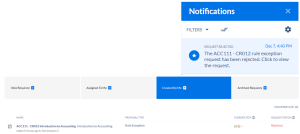
- If Rejected, the schedule builder will see the following in their Requests dashboard, and the section update will not occur:
- Suspended
- If Suspended, the schedule builder will see the following in their Requests dashboard, and the section will remain as-is until a decision is made:
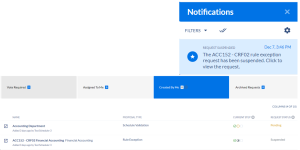
Note: The approver can update a Suspended Request to either Approved or Rejected.
- If Suspended, the schedule builder will see the following in their Requests dashboard, and the section will remain as-is until a decision is made:
- Approved
Unable to Submit Rule Exception Request?
Rule Exception Requests can only be submitted once a section has been created, they cannot be submitted on brand new sections. It will only prompt the Rule Exception Requests on sections where a section ID exists. On new sections, the section ID will not exist until the section is saved. You can save, and go right back into the section to submit the Request, or route to Requests and Create a Request.

